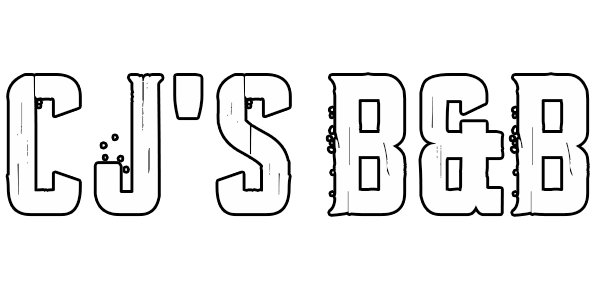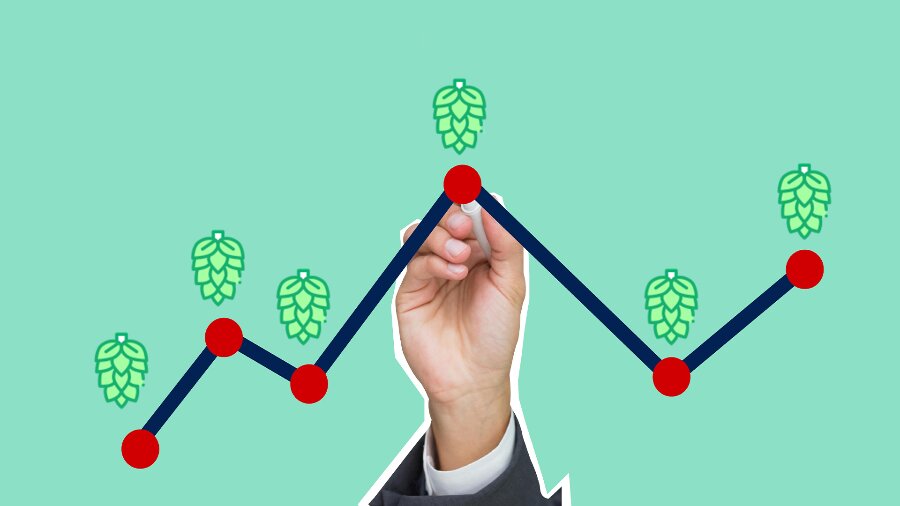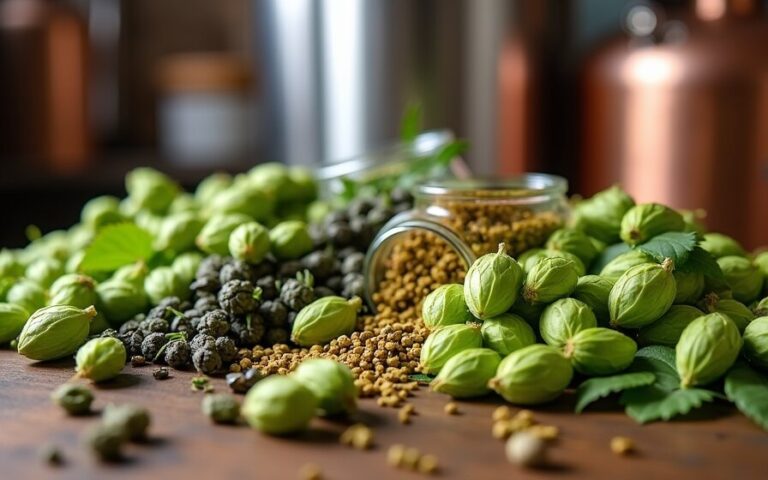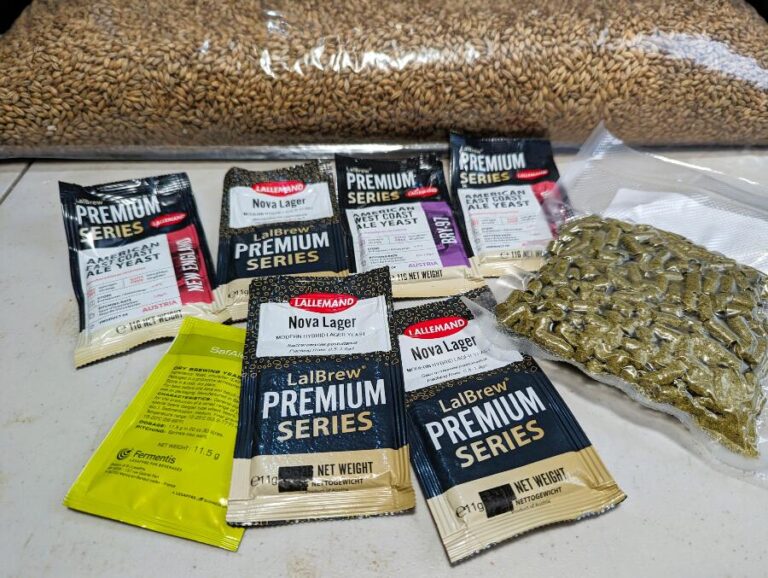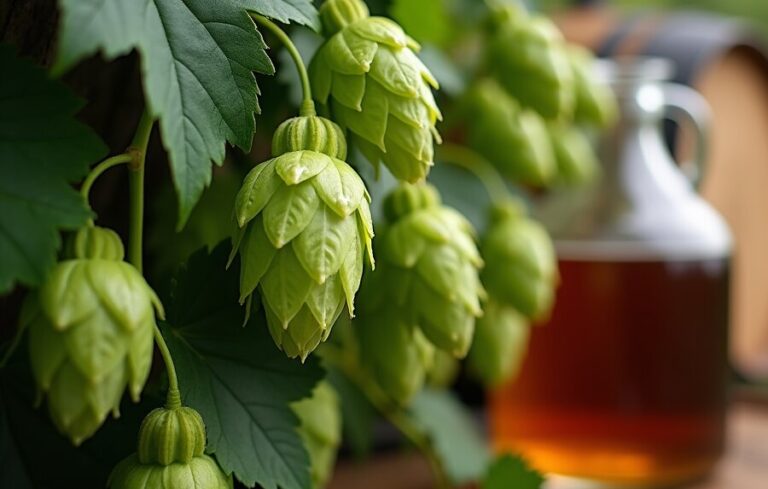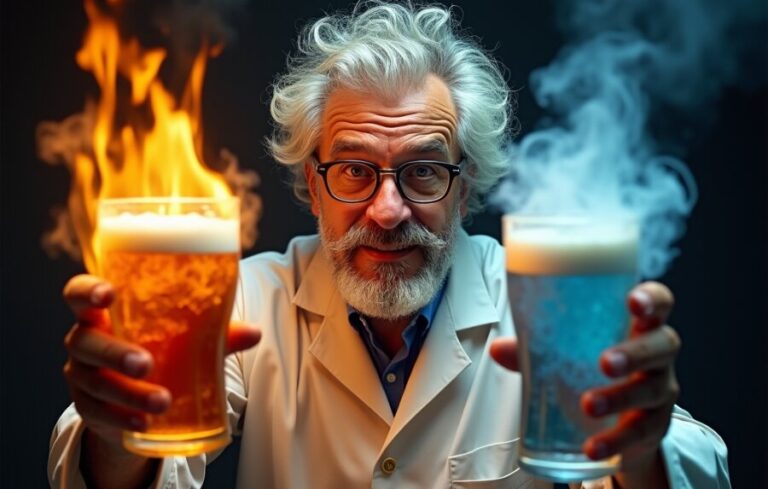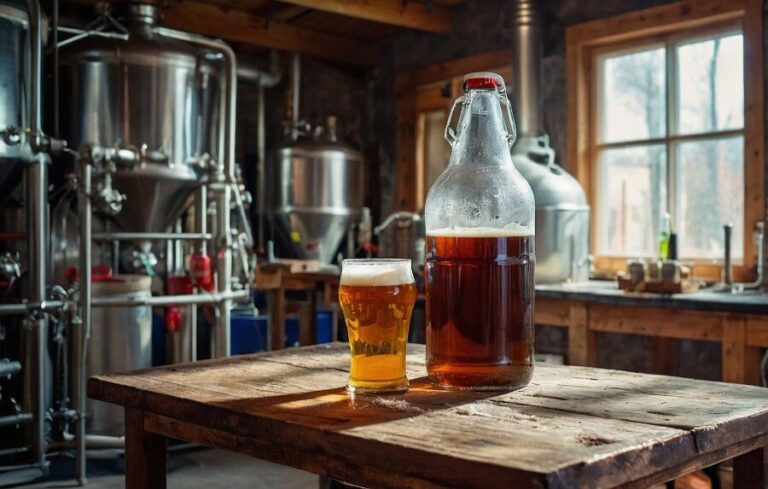Our evaluations and product assessments are conducted using a thorough and unbiased approach. Should you choose to buy any items through our provided links, we might receive a commission Read our disclosures.
Understanding Hop Utilization
As I dive into the world of homebrewing, understanding hop utilization becomes essential for crafting the perfect brew. Hop utilization in homebrewing refers to the fraction of available alpha acids that transform into isomerized forms and remain in the finished beer. Typically, this is around 25 percent, but various factors can influence this number.
Factors Influencing Hop Utilization In Homebrewing
Several variables can impact the efficiency of hop utilization. Here are some key factors to consider:
| Factor | Influence |
|---|---|
| Boil Time | Longer boil times generally lead to higher utilization, as more alpha acids have time to isomerize. |
| Temperature | Higher boiling temperatures improve isomerization and thus increase utilization. |
| pH Level | The pH of the wort can affect how well hops dissolve and release their oils, influencing overall utilization. |
| Gravity of the Wort | Higher gravity worts can reduce hop utilization, as the increased sugar concentration can inhibit isomerization. |
| Hop Variety | Different hop varieties have varying alpha acid concentrations, affecting how much bitterness they contribute. |
Adjusting these factors can help me optimize my hop utilization for each brew. For practical advice on techniques, I recommend checking out the article on bittering hops for homebrewing.
Calculating International Bitterness Units (IBUs)
International Bitterness Units (IBUs) provide a standardized way to measure the bitterness of beer, which is closely tied to hop utilization. One IBU is defined as one milligram of iso-alpha acid per liter of beer, or one part per million. Higher hop utilization results in more isomerized alpha acids, leading to a higher IBU value.
To calculate the IBUs in my brew, I can follow this simple approach:
Determine the amount of hops used (in grams) and their alpha acid percentage.
Use the formula:
[
\text{IBUs} = \frac{\text{grams of hops} \times \text{alpha acid %} \times \text{utilization factor}}{\text{liters of wort}}
]
Utilization factors vary based on boil times and other conditions. For instance, using a shorter boil time might yield a lower utilization factor.
For an accurate measurement of a beer’s bitterness, it’s best to use standardized methods. The American Society of Brewing Chemists has established techniques that separate iso-alpha acids using an ultraviolet spectrometer. Many brewers, including me, find that brewing software like BeerSmith can provide reasonable estimates for IBUs based on established formulae, which is adequate for most homebrewers.
Understanding hop utilization and how to calculate IBUs can greatly enhance my brewing experience and help me achieve the desired flavour profiles in my homebrew. For more information on hop flavours, check out hop flavors in homebrewing.
Practical Tips for Optimal Utilization
When it comes to achieving the best hop utilization in homebrewing, there are several practical tips I’ve found to be effective. From adjusting boil times to utilizing different brewing methods, these strategies can help maximize the flavour and aroma of my brews.
Adjusting Boil Times and Techniques
The boil time and temperature are crucial factors that influence hop utilization. Generally, the longer and more vigorous the boil, the higher the hop utilization. However, boiling hops for too long can lead to a decrease in volatile aroma compounds, affecting the overall flavour (Fatty’s Beer). Here are some adjustments I consider:
| Boil Time | Utilization Effect |
|---|---|
| 60 minutes | Best isomerization; recommended for initial hop additions |
| Last 15 minutes | Ideal for preserving aroma and flavour hops |
| 30 minutes | Good balance for both bitterness and aroma |
I also reserve a portion of my extract for the last 15 minutes of the boil to concentrate the wort. If I’m using hot whirlpools or hop stands, I reduce the 60-minute bittering charge to optimize hop utilization (Beer and Brewing).
Utilization in Different Brewing Methods
Different brewing methods can impact hop utilization in homebrewing significantly. For instance, when brewing with extract, I make sure to boil the first hop addition for at least 60 minutes. This practice helps achieve the best isomerization without evaporating more than about 10% of the wort volume (Brew Your Own).
Using two kettles for a full-volume wort boil is another effective method I’ve tried. This technique allows for easier handling and boiling on a kitchen stove, enhancing hop utilization significantly. Here are a few methods to consider for optimizing hop utilization:
| Brewing Method | Recommended Techniques |
|---|---|
| Full-Volume Wort Boil | Use two kettles to manage volume |
| Continuous Hopping | Add small amounts of hops throughout the boil |
| Whirlpool and Hop Stand | Add hops after boiling for flavour retention |
| Dry Hopping | Enhance aroma without additional bitterness |
By applying these techniques, I can make the most of my hop varieties and ensure that each brew is packed with flavour. For more insights on selecting the right hops, check out our article on best hops for homebrewing and hop flavors in homebrewing.
Enhancing Hop Utilization
When I embark on a homebrewing adventure, enhancing hop utilization becomes a key part of my process. Understanding how to select the right hops and applying effective techniques can make a significant difference in the final product’s flavour profile.
Proper Hop Selection
Proper hop selection plays a vital role in optimizing hop utilization for my brews. The alpha and beta acid content of the hops I choose directly influences the bitterness and aroma of my beer. Generally, I find that using hop pellets or extracts offers better utilization rates compared to whole cone hops. This is primarily due to the increased surface area of pellets, which allows for more efficient extraction of essential oils and acids during the boiling process (Fatty’s Beer).
Here’s a quick reference table of common hop varieties and their alpha acid content:
| Hop Variety | Alpha Acid Range (%) | Best Usage |
|---|---|---|
| Cascade | 4.5 – 6.7 | Aromatic and flavour hops |
| Centennial | 9.0 – 11.0 | Bittering and flavour hops |
| Simcoe | 12.0 – 14.0 | Bittering and aromatic hops |
| Chinook | 12.0 – 14.0 | Bittering hops |
| Citra | 11.0 – 14.0 | Aromatic and flavour hops |
For more information, check out our guide on the best hops for homebrewing.
Techniques for Maximizing Utilization
To maximize hop utilization in my brewing process, I employ several techniques that have proven effective. These include optimizing boil time and temperature, continuous hopping, and making use of whirlpool and hop stand techniques.
Optimizing Boil Time and Temperature: The degree of isomerization that occurs during boiling can greatly affect hop utilization. I aim for a boil time of at least 60 minutes to ensure proper bitterness extraction, while keeping the temperature consistent.
Continuous Hopping: This method involves adding small amounts of hops throughout the boil rather than all at once. This technique not only enhances bitterness but also allows for a more complex flavour profile.
Whirlpool and Hop Stand Techniques: After the boil, I often whirlpool the wort to create a vortex, which helps extract more oils from the hops. Following this, I may let the hops steep in the hot wort (hop stand) for additional flavour and aroma extraction without further bitterness.
Dry Hopping: Adding hops after fermentation can introduce fresh hop aromas and flavours without increasing bitterness. This technique is essential for creating hop-forward beers.
For more tips on hop flavours and substitutions, feel free to explore our articles on hop flavors in homebrewing and hop substitutions for homebrewing.
By focusing on proper hop selection and employing these techniques, I can significantly enhance hop utilization and create the flavorful, aromatic homebrew beers I enjoy.

Hop Utilization in Large-Scale Brewing
When I think about brewing at a larger scale, hop utilization becomes a crucial factor in creating flavourful beers. The equipment I use can significantly impact how effectively I extract the desired flavours and bitterness from the hops.
Impact of Brewery Equipment
The design and size of brewery equipment play a vital role in hop utilization. Factors like kettle design, wort aeration, recirculation systems, hop filtration methods, and temperature control can all affect how well hops are utilized during brewing. For instance, investing in a kettle with efficient heat distribution can help ensure that the hops are fully extracted.
Here’s a quick overview of how different equipment impacts hop utilization:
| Equipment Type | Impact on Hop Utilization |
|---|---|
| Kettle Design | Affects heat distribution and hop extraction efficiency |
| Wort Aeration | Enhances hop oil solubility |
| Recirculation Systems | Ensures even extraction of hop compounds |
| Hop Filtration Methods | Prevents clogging and maintains flow |
| Temperature Control | Helps in achieving optimal extraction temperatures |
Using the right equipment not only maximizes hop extraction but also helps maintain the desired flavour profile in the final product. Techniques such as continuous hopping, whirlpool, hop stand, and dry hopping can also be employed to enhance hop utilization further (Fatty’s Beer).
Measuring and Evaluating Utilization
Measuring and evaluating hop utilization in homebrewing is essential for maintaining consistency and quality in my brewing process. I can use methods like International Bitterness Units (IBUs), sensory evaluation techniques, quality control measures, and even in-house lab analysis. These tools help me monitor the extraction of hop compounds and optimize my brewing process.
The bitterness equation used in the hop utilization models—Tinseth, Garetz, and Rager—provides a systematic way to calculate bitterness in my brew. Here’s a brief look at the equation:
Bitterness Equation:
[ \text{IBUs} = \frac{(\text{UTILIZATION} \times \text{ALPHA_ACID_PCT} \times \text{WT_OZ} \times 0.7489)}{\text{VOL_GAL}} ]
Where:
- ALPHAACIDPCT = Percent alpha acid content in the hops
- WT_OZ = Weight of hops in ounces
- VOL_GAL = Volume of beer in gallons
- UTILIZATION = Utilization factor specific to the model used
Understanding how to apply these models allows me to predict the bitterness of my beer accurately. This knowledge ensures that each batch I brew meets my expectations and the preferences of those who enjoy my beer (BeerSmith).
By focusing on hop utilization in large-scale brewing, I can enhance the flavour and quality of my homebrew, ensuring every sip is as enjoyable as the last. For more insights on the best hops to use, check out our guide on best hops for homebrewing.
The Science Behind Hop Oils
Understanding the role of hop oils in brewing is crucial for enhancing my homebrew experience. Hop oils contribute to both the aroma and flavour of the beer, making them essential for creating a balanced and enjoyable brew.
The Complexity of Hop Oils
The complexity of hop oils is fascinating. As of 2008, there were 485 hop compounds identified, with evidence suggesting that there may be over 1,000 hop oil compounds that could be present in different hop varieties (Scott Janish). This diversity means that each hop variety can impart unique characteristics to the beer, influencing everything from bitterness to aroma.
During the brewing process, it’s important to note that many of these hop oils can escape during the wort boiling phase. For example, compounds like myrcene and linalool have low boiling points, leading to significant loss during boiling. Conversely, other compounds such as humulene, farnesene, caryophyllene, and geraniol have slightly higher boiling points and tend to retain more of their oils throughout the boil. Here’s a quick overview of some common hop oils and their boiling points:
| Hop Compound | Boiling Point (°C) | Loss During Boil |
|---|---|---|
| Myrcene | 166 | High |
| Linalool | 198 | High |
| Humulene | 222 | Moderate |
| Farnesene | 145 | Moderate |
| Caryophyllene | 160 | Moderate |
| Geraniol | 230 | Low |
Influence of Fermentation on Hop Oils
Fermentation also plays a significant role in the evolution of hop oils. A 2013 study found that hop oils significantly decreased after fermentation, particularly floral oil compounds like myrcene, which tend to diminish during this process. However, linalool showed the greatest ability to persist through fermentation (Scott Janish).
This means that to maximize the hop flavour and aroma in my beer, I need to consider both the timing of the hop additions during brewing and how the fermentation process will affect those oils. It’s a delicate balancing act that can make a big difference in the final product.
For those interested in exploring hop varieties further, I recommend checking out our guide on the best hops for homebrewing and the various hop flavors in homebrewing to better understand how to select hops that align with my brewing goals.
Hop Utilization Models
As I dive into the world of homebrewing, understanding hop utilization in homebrewing is essential for crafting the perfect brew. There are several models designed to help me calculate the bitterness of my beer, measured in International Bitterness Units (IBUs). The three primary hop utilization models are Tinseth, Garetz, and Rager. Each has its own method for estimating bitterness, and it’s worth exploring how they differ.
Tinseth Utilization Model
The Tinseth model, developed by Glenn Tinseth, is the most widely used hop utilization model among homebrewers. It calculates utilization based on a time factor combined with a wort gravity factor. Essentially, this means that the utilization of hops decreases as the gravity of the wort increases but increases with longer boil times.
The basic equation used in this model is:
[
IBUs = \frac{(UTILIZATION \times ALPHA_ACID_PCT \times WT_OZ \times 0.7489)}{VOL_GAL}
]
Here, ALPHAACIDPCT represents the percentage of alpha acids in the hops, WTOZ is the weight of the hops in ounces, VOLGAL is the volume of the wort in gallons, and UTILIZATION is the factor specific to the Tinseth model.
Garetz Utilization Model
The Garetz model is another option for calculating hop utilization. This model aligns closely with the Tinseth model for longer boil times, making it a solid alternative for brewers who prefer extended boiling. The Garetz model also factors in the time and wort gravity but approaches the calculations slightly differently.
Brewers often find that the Garetz and Tinseth models yield similar results, especially in longer boils. However, it’s worth noting that the Garetz model may not be as widely adopted as Tinseth among homebrewers.
Rager Utilization Model
The Rager model is known for estimating higher utilization rates for boil times exceeding about 18 minutes. This can be particularly useful for those who are brewing with extract, as it was popular among extract brewers. However, Rager’s estimates can be substantially higher than those from the Tinseth model, especially for shorter boil times.
The Rager model also uses the same basic IBUs equation as the others but includes a different utilization factor. Many brewers appreciate the Rager model’s simplicity and its effectiveness for certain brewing methods.
| Model | Best For | Boil Time Impact | Popularity |
|---|---|---|---|
| Tinseth | General brewing | Utilization increases with longer boils | Most popular |
| Garetz | Longer boil times | Aligns with Tinseth for long boils | Less common |
| Rager | Extract brewing | Higher utilization for longer boils | Popular with extract brewers |
Understanding these models can significantly impact how I approach hop utilization in my homebrewing process. Each model offers unique insights, and I can choose the one that best fits my brewing style and preferences. For a deeper dive into selecting the right hops, check out our guide on the best hops for homebrewing.

